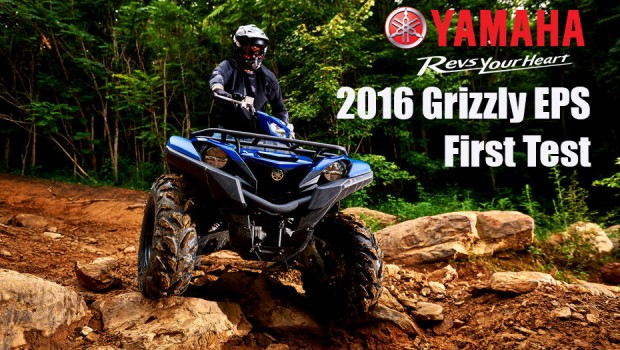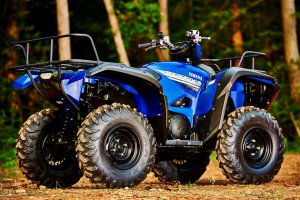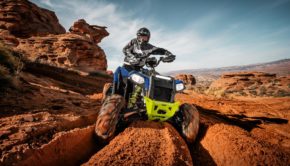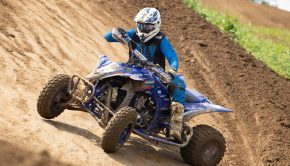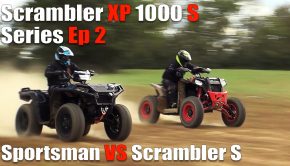2016 Yamaha Grizzly 700 EPS, First Test: WITH VIDEO
Everything that made the Grizzly 700 great, made better in almost every way.
Originally released in 2007, the Grizzly 700 received its last major overhaul in 2014. Although it looked very much the same, it received a two-inch wider track, and recalibrated suspension, among other changes. In spite of retaining the top-seller status in the big-bore 4×4 segment, Yamaha decided to make an even larger number of significant changes for 2016. Headed up by a striking, new outward appearance, Yamaha updated nearly every aspect of the machine for improved performance across the board, looking to better serve sport 4×4 enthusiasts. They also managed to enhance its versatility with more on-board storage and improved work capabilities.
Technical Breakdown
Starting at the heart of the machine, Yamaha replaced the Grizzly’s 686cc SOHC, single-cylinder engine with the 708cc, liquid-cooled, DOHC engine used to power the new Wolverine R-Spec UTV. Displacement was upped 22cc along with compression up from 10.0:1 to 10.1:1.
The air box has been relocated to a more conventional location, under the seat, with the 700’s various intake and vent points routed up high in the center of the machine for water and dust resistance. Along with providing tool-free access and removal of the filter, the air box and filter have been increased in size. The new air box location results in the intake tract being increased from 60mm to 200mm, which is claimed to improve torque and throttle response. All of these changes result in an engine claimed to produce 6% more power and 9% more torque.
Yamaha’s Ultramatic CVT transmission utilizes a centrifugal clutch to handle clutch engagement, helping eliminate belt slippage for improved durability. It features high and low forward ranges, in addition to neutral, reverse, and park. This year, Yamaha made the switch from 25 to new 26-inch Maxxis tires, to increase ground clearance, improve traction, and ride comfort. To retain engine performance with the taller tire size, Yamaha lowered the transmission’s gear ratio 5% in high range. For harder hitting, snappier throttle response, the CVT’s clutch weights were reduced from 20g to 18g.
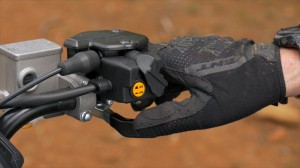
The drive train features two-wheel-drive, four-wheel-drive with limited front slip, or four -wheel-drive with differential lock.
The drive train features two-wheel-drive, four-wheel-drive with limited front slip, or four -wheel-drive with differential lock. To match durability to the increased power and larger tires, Yamaha went with larger CV joints, up 3.6mm front and 4mm rear.
While the chassis remains very similar to last year’s, the steering stem’s pitman arm was shortened 2.9mm accompanying new mapping for the electric power steering. Fully independent suspension equipped with a rear sway bar deliver 7.6 inches of travel up front and 9.1 inches out back. Suspension stroke was increased 1.2mm front and rear. The front springs went from a progressive rate to a single rate spring with a firmer initial spring rate. The rear springs received a softer initial spring rate with the same firmness as 2015 at full compression. The gas-charged shocks received revised internal damping to match, and five-way preload adjustment is found at all four corners.
Stopping the Grizzly are separate front and rear hydraulic disc brakes featuring dual-piston calipers at all four corners. For improved durability, the wheel hubs were switched from a cast to a forged design for 2016.
The new bodywork brings a more modern and muscular look to the Grizzly’s styling. The taller tires with the taller, flatter fenders yield a more squatted and eager looking machine. An all-new seat is 60mm longer. Its foam is thicker and has revised density for improved comfort and ease of movement.
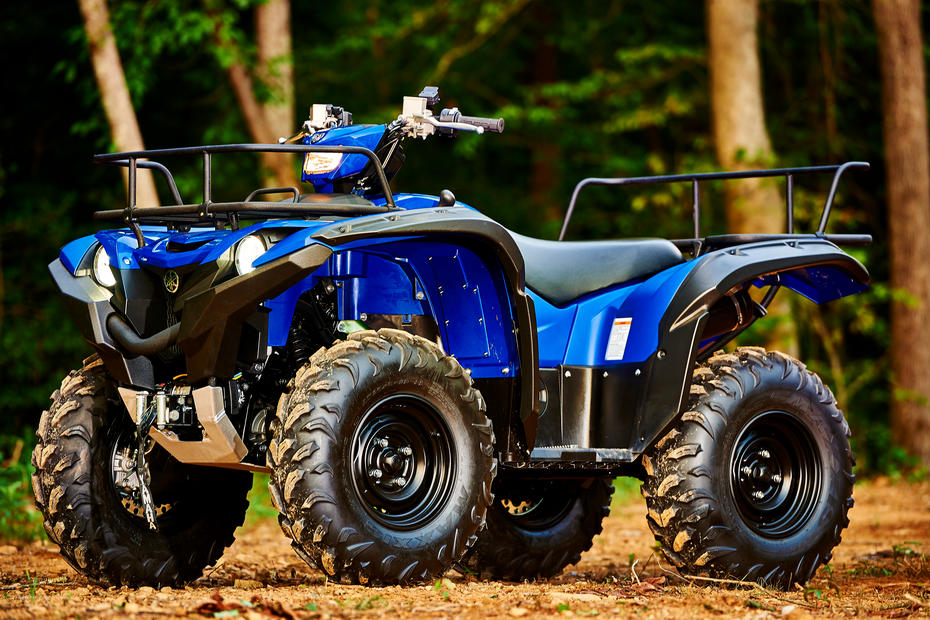
The new bodywork brings a more modern and muscular look to the Grizzly’s styling. Pictured with optional accessories.
A new handlebar-mounted light pod and digital display combo, illuminate the trail in the direction the handlebars are pointing. The already existing front headlights and taillights have gone to LEDs for 2016, yielding more light and less energy consumption.
The gas tank fill point has been moved to the right rear fender, making room for a new storage compartment between your knees. There is a new rear storage compartment under the rear headlight, in addition to the already existing storage compartment on the right front fender. The Grizzly’s steel racks have been beefed up for 2016 increasing their capacity by 11 pounds at each, to 110 pounds front and 198 pounds rear, in addition to its 1,322 pound towing capacity.
The new Grizzly measures in at 48.4-inches wide, with a 49.2-inch wheelbase. Thanks to the taller tires, ground clearance has been increased ½ inch to 11.3 inches, as has the seat height, now at 36.1 inches. All of the changes have added a 44 weight increase, now at 692 pounds wet, while fuel capacity was slightly decreased from 5.3 to 4.76 gallons.
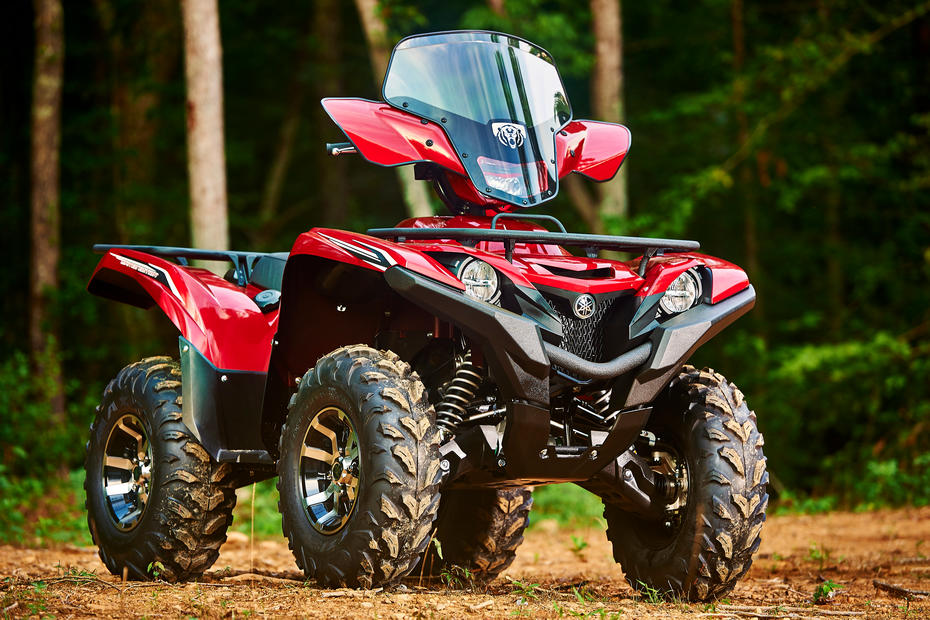
for hard-core enthusiasts who challenge the elements and the terrain, Yamaha ‘s offering a Limited Edition Grizzly with the SE’s added features, plus a removable windscreen, heated seat, heated grips, heated thumb warmer, and a unique Crimson Metallic painted bodywork.
Yamaha is offering four variations of the Grizzly: a base model; the EPS-equipped version we tested; a Special Edition version with cast aluminum, two-tone wheels, Carbon Metallic painted plastic, and a 2-inch receiver hitch, instead of the standard tongue and ball mount. Finally, for hard-core enthusiasts who challenge the elements and the terrain, Yamaha ‘s offering a Limited Edition Grizzly with the SE’s added features, plus a removable windscreen, heated seat, heated grips, heated thumb warmer, and a unique Crimson Metallic painted bodywork.
Hitting the Trail
Yamaha had us out to Wind Rock Park, located in Oliver Springs, Tennessee, to put the 2016 Grizzly 700 EPS to the test. Offering trails of varying speeds and difficulty levels, the name of the game at Wind Rock is rocky and technical.
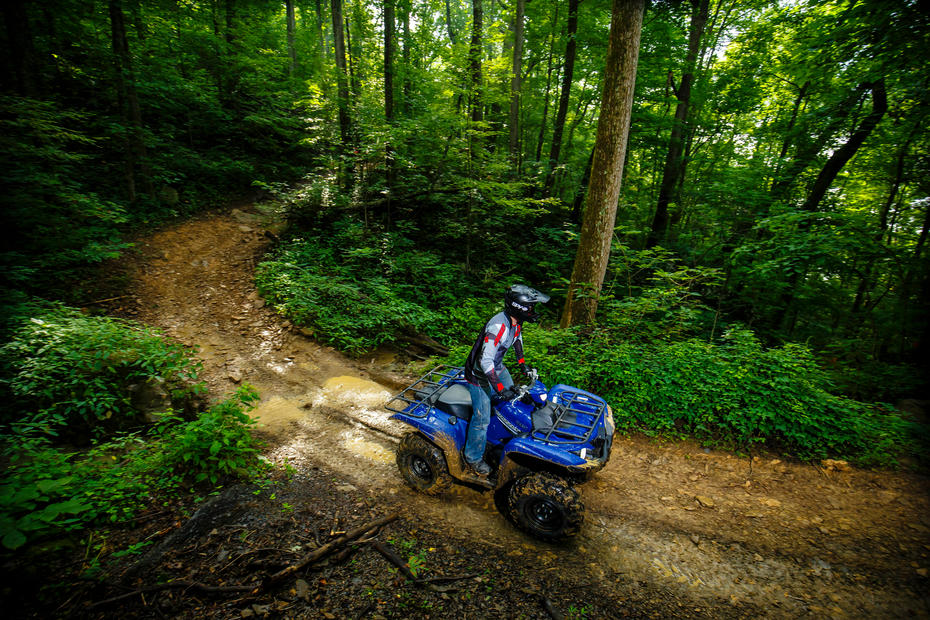
Hitting the trail, the sound and power characteristics of the new 708cc engine are very similar to its predecessor, but with a noticeable increase in midrange power and torque.
Hitting the trail, the sound and power characteristics of the new 708cc engine are very similar to its predecessor, but with a noticeable increase in midrange power and torque. A slight rise in the trail and a blip of the throttle are all that’s needed to pull a wheelie at cruising speeds. Strong low-end grunt makes the big single very capable picking your way through rock-strewn, hilly trails. Even in the gangliest sections, we rarely saw the need to shift out of high range, as long as we could maintain a little momentum. Belt slippage was never an issue. Low range saved us on a couple of occasions when we chose a bad line and had to work our way out of a tricky situation. On the few fast sections we encountered, top-end power was good for a big single; however, this big-bore does its best work on curvy trails with shorter straightaways, allowing you to make best use of its good torque and strong responsive midrange.
We found the new engine’s performance pretty flawless, although we did noticed some quiet popping coming from the exhaust under deceleration. We also noticed that a little throttle was needed to bring the engine to life on hot starts. We suspect Yamaha is running the air/fuel mixture lean off the bottom to meet emission standards leaving power to be had with a richer fuel map at hop-up time.
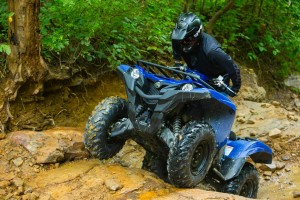
As we have come to expect from Yamaha, drivetrain performance was flawless. The drive selection switch features slick operation.
As we have come to expect from Yamaha, drivetrain performance was flawless. The drive selection switch features slick operation. We spent a majority of our time riding in limited slip four-wheel-drive, switching out on fast trails, and locking in the front differential for times when we wanted nothing to chance. When going downhill, the engine brake felt smooth, and natural, with the right amount of braking power, delivered to two or four wheels, depending on your drive selection.
The taller tires and revised suspension improved the overall ride of the machine, allowing it to roll more smoothly through the small rocks, roots, and bumps that wear on you during long rides. This was accomplished without sacrificing the suspension’s firm, sporty feeling. The shocks did a good job of dealing with impacts with half buried boulders. G-outs could be tackled without the suspension wallowing and the moto-heads among us were treated to a number of water breaks providing some air-time. Landings were plush and controllable even landing a little crossed up. We overcooked one large water break and managed to bottom the shocks, although it was hardly noticeable through the handlebars.
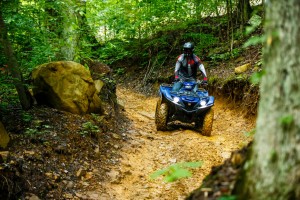
The added width from 2014, plus 2016’s firmer initial front shock settings and new tires, result in a front end that rolls less in corners and on side hills.
On the generation 1 Grizzly, we used to crank up the front shocks’ preload to help fight body roll. The added width from 2014, plus 2016’s firmer initial front shock settings and new tires, result in a front end that rolls less in corners and on side hills. The new front end holds up better to heavy braking on rough, steep descents with better suspension action, directional control, and less diving. With more time on the new machine, we would have even tried backing out all the shocks’ preload one notch to the softest setting to test their limits of plushness.
What’s best about the Grizzly’s improvements in handling and suspension over the past three years is that they haven’t seemed to come with any drawbacks. The 700 retains the light and nimble feeling that the behemoths over 800cc lack. Directional control is excellent at low to intermediate speeds, with just enough scrub to keep the Grizzly from feeling twitchy at higher speeds. The recalibrated power steering settings resulted in what felt like lighter steering effort at low speeds. Yamaha’s EPS settings leave you feeling in touch with how the machine is responding to the trail. However, we would like a little more damping effect on impacts from larger obstacles and a little more steering assistance when the front differential is locked. For the boulders we couldn’t pick a line around, the Grizzly’s ground clearance was surprisingly good.
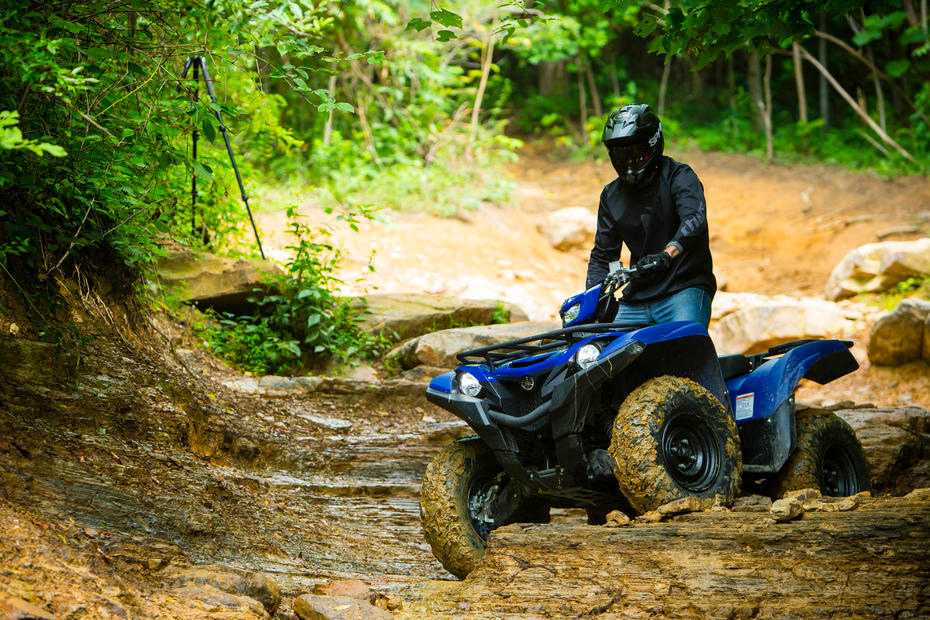
What’s best about the Grizzly’s improvements in handling and suspension over the past three years is that they haven’t seemed to come with any drawbacks. The 700 retains the light and nimble feeling that the behemoths over 800cc lack.
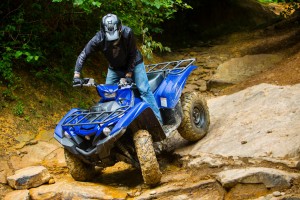
Braking performance on the Grizzly continues to be the best we have ever experienced on any 4×4 ATV period.
Braking performance on the Grizzly continues to be the best we have ever experienced on any 4×4 ATV period. They offer superb feel and lots of stopping power. One finger per hand is all that’s needed to wield serious braking force.
Ergonomics are improved for 2016. The seat offers a greater level of comfort for long rides. Its flatter design and smoother transition into the bodywork let you more easily slide fore and aft for aggressive riding. While standing, we felt just a little cramped leaning forward for steep, low-speed climbs. Rotating the bars forward or switching to a lower bar would help. The one item we wish Yamaha added to the sportier 2016 Grizzly was a set of taller, wider foot pegs for better feel and function. Yamaha offers a set of oversized accessory pegs for $56.99. They’re available at your local Yamaha Dealer or at www.shopyamaha.com.
We applaud Yamaha for doubling down on stronger steel racks. Steel racks work better than composite works, period. The new light pod limits your handlebar options, but the benefits of directional lighting make it a win. What’s best is that all three lights can be operated at the same time.
Conclusion
At $9,699, Yamaha has added a lot of additional performance and features for a small $200 price increase. While definitely not inexpensive, it sits in the middle of the 650cc-750cc prices. The 2016 Yamaha Grizzly 700 has everything that made the Grizzly great, improved upon in almost every way! The engine feels familiar, yet a little more potent and fun to ride. It feels as nimble as ever, but with more stability and enhanced suspension action. It’s clearly improved for the sport-minded, while more capable than ever for those who need to get the job done.
Manufacturer: Yamaha
Model: 2016 Grizzly 700 EPS
MSRP: $9,699
2016 Yamaha Grizzly 700 EPS Ratings
Summary: At $9,699, Yamaha has added a lot of additional performance and features for a small $200 price increase. While definitely not inexpensive, it sits in the middle of the 650cc-750cc prices. The 2016 Yamaha Grizzly 700 has everything that made the Grizzly great, improved upon in almost every way! The engine feels familiar, yet a little more potent and fun to ride. It feels as nimble as ever, but with more stability and enhanced suspension action. It’s clearly improved for the sport-minded, while more capable than ever for those who need to get the job done.

